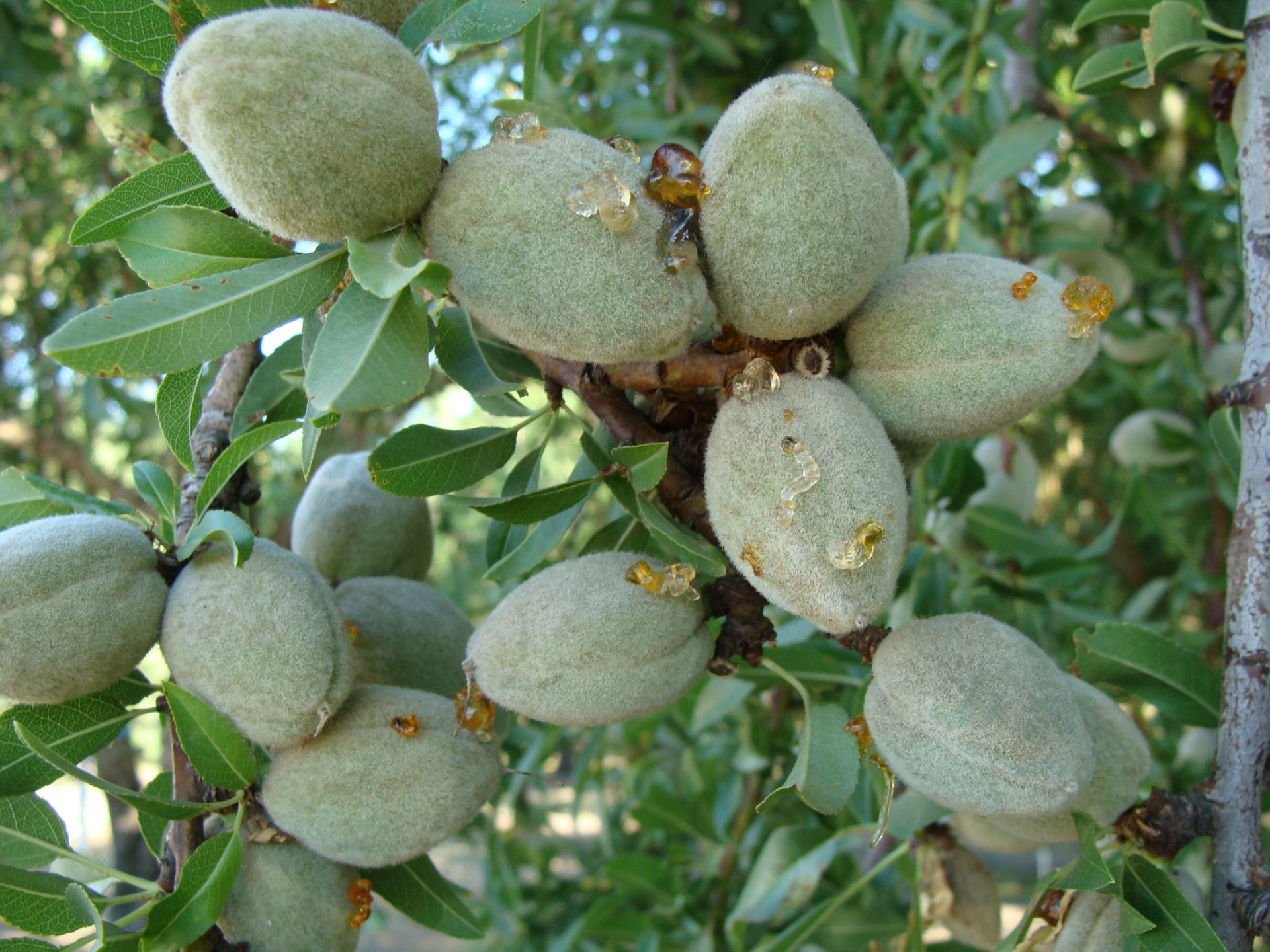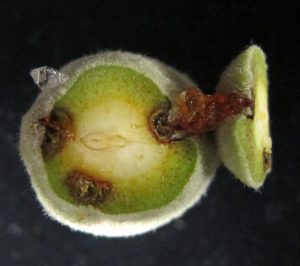
Two successive dry springs have led to reduced incidence of bacterial spot in almonds, but the disease continues to pose a risk in orchards with impact sprinklers that are interplanted with the Fritz cultivar.
And, according to UC Riverside Plant Pathologist Jim Adaskaveg, it would be a mistake for growers to assume the disease is no longer a threat. Given the right environmental conditions, bacterial spot can and most likely will rear its head again, regardless of which irrigation system is being used.
“The disease is still occurring and out there, but because we haven’t had wet springs, it isn’t very prominent,” Adaskaveg said. “But it is surviving at low levels even in orchards that have the type of irrigation systems, such as drip or microsprinkler, that limit the spread of the pathogen by keeping the canopy dry.”
Also, Adaskaveg said, since its discovery in the Sacramento and northern San Joaquin valleys nearly a decade ago, the disease inoculum has now spread throughout the state’s almond growing regions.
“We’ve had it in our plots down in the north Modesto area, and we’ve had people send samples from Kern County as well. And I have collected samples in Colusa and Glenn, and I’m sure it is in Tehama and Butte counties, too,” Adaskaveg said. “It is across the whole state.”
Long a major problem on peaches in the Eastern U.S., bacterial spot caused significant crop loss in the Sacramento and northern San Joaquin valleys when it was first identified in California nearly a decade ago, in part because of its unfamiliarity to growers.
“Back in 2014, we weren’t aware of its presence in almonds,” Adaskaveg said. “We were thinking there were other causes. Since then, UC ANR farm advisors and UC researchers determined the cause by isolations, culturing and conducting Koch’s postulates that resulted in expanded understanding of this disease.”
The disease occurs mainly on the Fritz cultivar, but when inoculum is high and conditions are conducive to disease development, it can spread to other cultivars.
“Nonpareil, Butte, Carmel and Price are mostly resistant,” Adaskaveg said. “But, when Fritz gets it, if they are interplanted and the rain and the environment become very conducive, then it can rapidly increase on Fritz and then spread to other varieties as well.”
Still, crop loss in other varieties is minor compared to the potential for crop loss in Fritz, he said.
Disease Symptoms
Caused by Xanthomonas arboricola pv. pruni, bacterial spot shows up as small, watery blemishes on almond hulls that produce light- to dark-amber gumming. Lesions can slowly increase in size during the season as the infection extends into the hull, according to UC IPM Guidelines.
Early season infection can lead to fruit drop, and infections that reach the kernel can cause off-grades or unmarketable fruit. Symptoms are first visible seven to 21 days
after infection.
Leaf symptoms, which are less common than fruit symptoms, include small, water-soaked circular lesions that develop mainly along the midrib and toward the tip and margin of a leaf where water accumulates. Lesions become chlorotic and then turn brown and necrotic, according to UC IPM literature. Some lesions will abscise, creating small holes with the appearance of shot holes, while other lesions may coalesce to create larger irregular lesions. Under severe disease severity, some tree defoliation may occur.
Fruit mummies on the tree act as the primary inoculum source with infections initiating on developing fruit, according to UC ANR literature. “The bacterial pathogen needs wet conditions to infect and splashing water to spread,” Adaskaveg wrote in Sacramento Valley Orchard Source. The pathogen infects through natural openings such as stomata (leaf pores) or wounds.
Severe infections are most common with frequent periods of rainfall or irrigation during fruit development, according to UC IPM Guidelines. High moisture conditions and warm (higher than 68 degrees F) temperatures are very favorable for infection.
Twig cankers also can harbor the pathogen during tree dormancy, according to the guidelines. However, under California conditions, infections of young green shoots in the spring and twig cankers are rare. Still, because stem cankers have been reported in other almond production regions of the world, Adaskaveg said he suspects that cankers may occur under favorable conditions.
Impact Sprinklers
In the absence of high rainfall, growers mainly at risk include those with high-angle impact sprinklers in orchards interplanted with Fritz, Adaskaveg said.
“People with high-angle impact sprinklers can get ahead of the disease with dormant season and in-season bloom-time treatments, but then when they stop spraying, the population builds back up again,” Adaskaveg said. “It is like you are spending this money and overall staying in neutral. You knock it back and then it builds back up again on an annual basis.”
Still, Adaskaveg said that he understands that growers are unlikely to invest in a new irrigation system or pull out a healthy orchard with impact sprinklers just because of bacterial spot.
Growers with other types of sprinkler systems have largely been able to forego dormant treatments for bacterial spot the last two years, Adaskaveg said. And, he said, with inoculum levels low, they probably don’t need to be thinking about a dormant spray anytime soon.
“If you are a grower who has microsprinklers and you have Fritz and the disease pressure is low, you wouldn’t necessarily think, ‘I have to apply a dormant treatment,’” Adaskaveg said. “You can come in at full bloom or right after that when we do traditionally get rain, say in late February or March, and you can manage it that way.
“And then when it dries out as the spring goes into summer, you are ahead of the game, because you are not increasing the disease because your irrigation is not hitting the canopy,” he said. “So, you are maintaining the status quo.
“You don’t necessarily have to follow a recipe that includes a dormant and in-season spray every year,” he said. “But, if you’ve had an outbreak the previous year, you have an opportunity with these dormant treatments to really knock it back. And then, with the in-season application, based on the rainfall, you could come in and give it a second treatment.”

Cultural Controls
Keys to minimizing issues with the disease include shaking mummies off trees and mowing them.
“These winter shakes are really good because they remove the inoculum from the trees,” Adaskaveg said. “And it is not just the bacterial spot pathogen you are removing. You are also taking care of insect problems like any navel orangeworm remaining in those nuts that didn’t get harvested. And there are other pathogens that persist in the nuts, such as anthracnose.”
Adaskaveg added that mummified fruit are like a fortress that organisms retreat to during dormant periods.
“If you shake and mow the mummies, then there are other saprophytic organisms, including bacteria in the soil, that are all going to be competing. And these plant pathogens don’t like competition, and their chances for survival with all the other competition is in your favor,” he said.
As for spray materials, UC IPM disease management guidelines call for use of copper or copper-mancozeb at delayed dormancy to reduce inoculum levels in the orchard, followed by a single in-season treatment in the spring, again with copper alone or a copper-mancozeb combination.
Cultural control recommendations include using strategies to improve air movement to reduce the relative humidity in an orchard, designing irrigation systems that reduce or prevent wetness of the tree canopy and following good sanitation practices.
Research has shown, incidentally, that early dormant treatments in mid-November or mid-December were less effective and that in-season treatments were most effective when timed around rain events and before temperatures rose above 77 degrees F in the spring.















